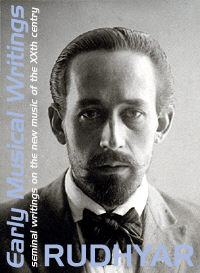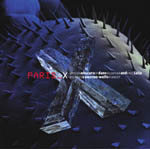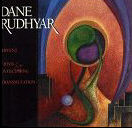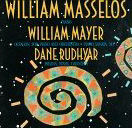 |
| Home | Bio | Art | Music | Literature | Civilization & Culture | Philosophy of Wholeness | Theosophy & Spirituality | Astrology |

THE DUALISM OF MUSICAL SUBSTANCE
D. Rudhyar Pro Musica Quarterly March 1928 In this provocative article, Rudhyar stress that "there are and always have been two fundamentally different types of music, roughly corresponding to feelings and mind, to spontaneous . . . expression and the deliberate production of tones for some magical or religious purposes, especially in connection with words and incantations. This 'music of mind' became public at the time of Pythagoras, in Europe as well as in India and China." The Early Musical Writings of Dane Rudhyar are made available for students of musical history and for scholarly research. Rudhyar was concerned that composers, students and scholars should not regard his earliest writings and articles - written while he was still a young man - as his most significant literary contributions to music. The reader is referred to Rudhyar's book The Magic of Tone and the articles The Transforming Power of Tone and When Does Sound Become Music for his mature and fully developed contributions. |
|
Related Articles |
|
Archived Music Articles |
|
|
Also Available Online |
|
» Rudhyar's Integration of Experience and Concepts - Music, from Leyla Raël's The Essential Rudhyar. |
|
Available Offsite |
|
Musical Works |
|
Musical Scores |
|
For scores of Rudhyar's musical works, visit the site of the American Composers Alliance. Musical scores 5 Stanzas and Granites are also available from SheetMusicPlus.com |
|
Also of Interest |

The Music of Rudhyar & Satie PARIS-X Musica Obscura Richard Cameron-Wolfe, Piano. Hear a sound clip 
Piano and String Compositions AVENT, CRISIS & OVERCOMING, TRANSMUTATIONS Marcia Mikulak, Piano and The Kronos Quartet 
An Earlier Recording of Rudhyar's Music Now on CD MASSELOS PLAYS RUDHYAR |
|
Home » Music » Articles on Music  Exactly as the history taught in the early grades — and even in high school — is essentially a collection of anecdotes, the narrative of the great deeds of great men, of battles, wars, discoveries covered with glamour, a drama whose protagonists are the heroes and villains of tradition, so also musical history is made up at present mostly of the lives of great composers, of personal incidents concerning their works, or at best of what this composer or the other did to develop this or that musical form, and so on. But underneath the fact that a composer was inspired or a mere imitator, underneath the general appearance or form of his works, something lies almost unruffled by the greatness or unworthiness of whomsoever agitates the surface of the sea of musical culture. Composers are the wavelets of this musical sea; the evolution of musical form might be compared to tides — which come and go and go regularly — as we see that musical genres follow a similar evolution in almost every racial culture, from sacred to profane types. But underneath waves, and more permanent than tides, are to be found vast sea-currents, and still farther the unmoved stillness of the abysses. The composer born in Germany in 1800 might be a Beethoven or a spiritless figure; but in any case he would be obliged to use the instruments, the notation, the scales, to conform to the general attitude to music of his civilization. He would have to use the musical substance of his race and epoch. Even today when this musical substance is breaking up, when fundamental ideas begin to be questioned and various racial attitudes to music, Eastern and Western, are coming in contact, it is an almost hopeless task for any composer to try to escape from tempered scales, pianos and standardized orchestrations, to bring forward a new "sense of tone " Miss Kathleen Schlesinger and Miss Hamilton in London, Mr. Carilto in New York, and others have attempted in their respective spheres to present a music whose substance is new and constitutes a definite departure from our European type. The efforts required are so overwhelming as to preclude almost the possibility of working along such lines for a composer who is essentially a creative force needing to express himself, and who moreover is not wealthy or favored with wealthy patronage. Musical substance is therefore a racial equation, not an individual one. It evolves but slowly following deeply rooted changes in the very substance of the racial mind of humanity; such changes are highly significant, when philosophically interpreted; knowing how to interpret them gives us a key to the world-history of Music. It broadens our musical horizon. It compels us to abandon our narrow, quasi-provincialistic view-point, according to which Music originated a few centuries ago in Europe, and everything before is to be regarded as "primitive music." A few musicologists, like Maurice Emmanuel in France, have attempted the study of our strictly European musical substance, of its scales and their genesis, of its sense of tonality, modes and what not. Their findings seem to us very incomplete, though extremely interesting and valuable in parts, but they do not seem to understand in the least the basis of archaic music, especially before Pythagoras and the 6th century B.C., and wish to enforce some sort of a diatonic scale on Music itself, whereas such corresponds only to one aspect of Music. On the other hand Miss Schlesinger, whose ideas are unfortunately at present but very fragmentally revealed, though she has been working for years towards a universal interpretation of musical substance which is essentially revolutionary from the orthodox musicologistic standpoint, comes out with a wonderful understanding of the substance of archaic music, with her system of Natural Intonation by which she, together with her associate Miss Hamilton, hopes to regenerate our artificialized and tempered music and lead it back to the natural condition which it had before the 6th century B.C. and had lost ever since. To us however each of these two lines of study deals only with one side of the question. MUSIC, as a universal, world-element, as a manifestation of Human Life, is essentially dualistic in its manifestations, although this dualism is founded on a unique principle, the Harmonic Series (or series of fundamental and harmonic overtones) which must be considered as the very Law of Sound, unchangeable and absolute — as the ever-still abyss of the musical sea. In other words, and attempting here but to give a very general and necessarily most incomplete presentation of the idea, there can be found two fundamental types of musical substance, to which can be reduced all the varieties encountered by one who studies the music of all races, Eastern and Western alike, past or present. Each of these two types gives rise to a certain type of basic musical progressions, out of which are evolved the various scales, modes, tonalities and so on used by the race at any particular time. Various names can be given to each type, according as we consider it from a technical or philosophical standpoint. Let us call these types: the natural type, and the archetypal type. All kinds of musical substance which are founded upon the Harmonic Series in a direct manner belong to the former; to the latter belong all types of musical scales which are generated by combining certain simple intervals, like fifth and fourth — as for instance the true Pythagorean gamut which was the basis of medieval European music. To put the idea in simple mathematical terms we shall say that the former type can be reduced to an arithmetical series, the latter to a geometrical series. In the first case we have a number (or in music the frequency of the fundamental) adding itself to itself perpetually, while in the second case we see a relation adding itself to itself (the proportion constituted by any two successive terms of the geometrical series being constant), or musically speaking, an interval. The Harmonic Series is thus a series of frequencies, that is of actual tones; while in the other type of musical substance we find essentially progressions of intervals. Tones or intervals: this gives us the fundamental meaning of this dualism of musical substance. We might say also: monads (or individuals) and groups (or relations between individuals). In other words, one type of music may be called essentially — music of the individual singing out his own selfhood, pouring out his own energy, impulse after impulse (and let us note that the Harmonic Series is really a series of periodical impulses of equal intensity); thus music dealing with energy, be it human emotional or solar magnetic energy; and on the other hand, music of the group, of relations, of functions, music dealing with the harmonious working out of parts within a whole; thus necessarily music of a scientific, (i. e. mental), character, of an organic and also of a cosmological character, as the cosmos may be, and has ever been considered by certain types of thinkers, as a great organism whose functional centers are marked by stars, suns, planets, whose functional rhythms can be seen in the revolutions of heavenly bodies. Thus the Pythagorean "music of the Spheres." It seems to be Miss Schlesinger's belief that what we call here the natural type has been exclusively in use during the archaic period of humanity, i. e. before the 6th century B.C. In a small paper entitled "Natural Intonatio — a new language of music," she writes: Natural Intonation is the oldest musical language in the world. It is as old as Sound itself, being founded upon the same natural law of proportional vibration. It grew up, as all languages do (except perhaps Esperanto. in accordance with the needs and aspirations of man; it owes but little- to theorists and musicians, who merely exercised a selective power over the infinite variety and richness of the material it afforded. From his earliest days, when the world was young, man has absorbed the language of Natural Intonations. He became aware through his ear of all natural sounds. . . . The harmonic overtones of his voice, to which his ear was extraordinarily sensitive, gave him what we call the major mode (the Harmonic Series ascending) while the minor mode (the Harmonic Series reversed) came to him later quite naturally when he attempted to make music with reed pipes and oaten straws. When Man therefore found out how to bore holes in the length of his river reeds, whereby one pipe was made to give many sounds, he came upon the beautiful Tropos scales. Of these he became so enamored that they ultimately formed the mystery language of the Ancient East, being connected with all forms of Sun Worship throughout the ages. While we do not altogether subscribe to every word herein quoted, especially to the assertion that the descending or minor mode came later than the ascending or major one, it seems definitely provable and probably will be found to be accurately proven by Miss Schlesinger's book when published, that the natural type of musical progressions based strictly on the Harmonic Series (but then we would say the descending Harmonic Series, as all archaic scales seem very definitely to have been descending scales) formed the foundation both of all popular music, and of that music which was connected with Sun-worship, solar or Dionysian cults, and the like. In other words all music which has to do with pure feelings, racial or individual emotions on one hand, and with all ceremonies and songs connected with the Sun and the natural magnetism of physical life — when such music is in a condition of purity and therefore of adequacy and harmony with — Nature is based on what can truly be called the principle of Natural Intonation. According to such a principle the scales (or rather modes) used are simple portions of the Harmonic Series, or if you want, octave slices. From overtone 2 to overtone 4 is one octave; also from overtone 7 to 14, or 11 to 22. If you take all the overtones between overtone 7 and overtone 14 you obtain a scale with seven notes in it; but if you chose the octave encompassed by overtone 11 and overtone 22, you get a scale with eleven notes in it. The higher the point of departure or tonic, the more notes you have to the octave. The important point is that all the notes so obtained are in simple relations to the fundamental of the series, their common ancestor. Thus we have called Natural Intonation the tribal order of music; as it is based on the idea of physical generation, each new octave being as it were a generation of brother-tones united together by community of blood and of origin. That there is a real community of origin among the overtones may not be found to be in accord with the ordinary conception developed in text-books of acoustics. In other words modern theoreticians may not admit that the fundamental is the source of the overtones, the seed out of which rises the stem of the Harmonic Series with its many overtone-branches, if we may suggest such a symbolic representation; but the science of acoustics is remarkable in the way in which it fails to deal with any fundamental question relating to the nature of Sound, of which it studies but the outermost manifestation, the sound-waves as they pass through the atmosphere. Following the old Aryan [the Indo-European culture of North India] conception of Sound, which Einstein's discoveries relating to the substantial nature of light ought to make still more plausible, Sound is essentially a sort of etheric flow, and we can speak of a Sound-ray very much as we speak of an X-Ray — i.e., as a definite and measurable emanation from the sound-producing instrument. Overtones correspond to successive transformations of the Sound-ray, or let us say they are various "modifications" of the substance of the Sound-ray issued from the fundamental, which is not only the lowest partial recognizable, but the very center of the total instrumental resonance. Logically therefore real "modes" are groups of overtones, a series of phases of the Sound-ray. Each characteristic group of overtones, each octave-group, has a definite beginning, corresponds to a sort of formula of differentiation of the Sound-ray; each "mode" is thus related to a certain emotion type, to a certain phase of solar magnetism (certain moments of the 11-year cycle of the sun). For instance the Hindu ragas which are (or rather were) Natural Intonation modes are made to correspond to seasons, days, hours, nature-gods, moods, etc. This probably would have applied to the archaic Greek modes, and Miss Schlesinger claims that "the Ancient Greeks regarded the modes as spiritual forces emanating from the planets (vide Nicomachus, Adrastus, Claudius, Ptolemy, and so on)" and reestablished the correspondences as follows:
When a Hindu singer sings these Hindu ragas he or she accompanies himself or herself with the persistent and unchanging sounds of the tambura. These sounds are the first four sounds of the Harmonic Series (the real musical Tetraktys of Pythagoras). Thus while the singer sings the various tones of a mode, these appear most obviously to be a group of overtones (chosen from the series of 22 overtones from overtone — 22 to overtone — 44: the twenty-two srutis) because the lowest tones of the Harmonic Series are being repeated over and over again by the tambura. The 'filial' relation of the tones of the raga to these fundamental tones of the tambura is thus always patent, inescapable — or at any rate it was so in ancient times before Hindu theoreticians began to consider the sruti as an interval-unit, which on the faith of the old texts and the very philosophy of Hindu music it never used to be. We can consider this old Hindu music, the expression of the individual Singer singing out his own selfhood throughout the many changes of life, (life within and without), as the typical manifestation of the pure Natural Intonation music. But all racial music, expression of the blood consciousness of the race, all music patterning itself upon the cycle of magnetic solar changes (the sun being the father and source of energy of this planetary system of ours, the spiritual Fundamental of all natural tones) and dealing with solar religions, can be said to be "natural music" and to have its source in the Harmonic Series. But there is another type of music, which has become more publicly known and has affected more definitely the official systems of music the world over since Pythagora's time, which however was obviously used before that time in the sanctuaries for magical purposes, especially in connection with the utterance of Names, with the recitation of Sacred Texts, be those the Vedas, or the early Christian, Gnostic Gospels. The utterance of Names is the basis of magic. A magical invocation is a rhythmical series of Names, that is of words having meaning in themselves, and not merely a conventional significance: i. e. words of power. A Name is constituted by a group of vowels and consonants, or in some cases, vowels alone. Vowels are like the colors, consonants like the outlines of objects (limiting thus the spread of the colors) in a painting. Vowels are the life, consonants the form; thus we cannot pronounce any consonant without adding some sort of a vowel. Vowels are typically seven in number (or less in un-spiritual tongues). These seven vowels correspond to the seven tones of what we will call the Gamut, in its diatonic aspect; and the magical Gamut-type, as used by Chaldeans, Gnostics and in all sanctuaries of the Archaic world, is a sort of seven-voweled incantation, which is the very incantation of Life in its sevenfold manifestation. From such a magical and occult incantation we come step by step to hymns, prayers, and the recitation of Sacred Texts, then of poetry in general; then to the separation of the diatonic tones themselves from the vowels, from the words — that is, to instrumental music. We can trace this process, philosophically if not always historically, if we begin with the most secret formulas of Gnostic brotherhoods in the first centuries of our era in Egypt and Syria, pass through the various types of plain-chant and end with the early polyphonic music of the Xlllth century, before the coming of what is called "Ars Nova" in the early XlVth century. This period of more than a millennium is the period of archetypal music in our European Christian civilization. In fact it really begins with Pythagoras, and the so-called Pythagorean Gamut is the progression-type of all archetypal music. Such a progression-type is generated by combining the intervals of fifth and fourth, and their progeny the whole tone. These three basic intervals, which produce the three tonal notes (tonic, sub-dominant, dominant) (C, F, G) correspond to the three primary colors of the spectrum. We know that our retina perceive only these three colors, and that all other colors result from the blending in our brains if these three. Likewise, by a simple operation, the other four notes of the diatonic scale are made to arise from these three basic ones, and the Gamut is constituted. We spoke elsewhere of the chemistry of tones, the great science which embraces both what we call to-day harmony and orchestration, the aim of which is the production of vital and sustained resonances. The Gamut is the basis of such a science. It is impossible to dwell more at length here upon a rather unfamiliar subject. What we wish to point out is merely that there are and always have been two fundamentally different types of music, roughly corresponding to feelings and mind, to spontaneous racial expression and the deliberate production of tones for some magical or religious purposes, especially in connection with words and incantations. This "music of mind" became public at the time of Pythagoras, in Europe as well as in India and China. The result of such revelation of theories which before were secret, has been rather disastrous. For a general confusion has ensued. The two types of music have become hopelessly mixed. Theoreticians have repeated more or less understandingly what Pythagoras taught, forgetting the basis of the preceding archaic music, or despising it. The musicians have been compelled to adopt the terminology proclaimed by the theoreticians, but went on playing the same kind of music. Later day theoreticians have attempted to interpret the latter in term of the former. Chaos has been the result and is still the result today, all over the world, in Europe, China and India — for the same reasons; solvable in the same manner. The major mode of European music and its tonalities are the results of such a chaos. The C major scale, the autocrat ruler over our musical substance, ought to have been a Natural Intonation mode; but as it was generated towards the 16th century, the pseudo-Pythagorean ideas and terminology were so strong yet, that while not being at all the Pythagorean gamut, it was used exactly as if it were such, though for emotional and popular purposes which are fundamentally opposed to the substance of the Gamut-type. This led to the adoption of equal temperament, as a result of the need for modulations and emotional expression; then eventually to the chromaticism of Liszt and Wagner, and Schoenberg's "duodecuple scale." It led to the present musical chaos, which will never be solved until the two fundamental types of music, musical substance and progressions, are recognized and understood in their philosophical as well as technical implications; and separated. This means studying LAWS, the very last thing a musician ordinarily wishes to do. To study universal LAWS is very different however from memorizing regulations concocted by European conservatories which were dead a century ago, and have kept dying ever since. Several pioneers are beginning to study Music in terms of universal Laws, to probe the meaning and contents of the musical substance which we are bound to use to-day if we want to be heard, to work toward the establishment of a new and fuller and more logical substance. We hope that Miss Schlesinger's ideas will prove an inspiration for practical work to courageous composers who would follow Miss Hamilton's example and create in term of Natural Intonation, of true modes. We hope that our popular and emotional music will be regenerated thereby. A West African composer, Mr. Nicholas G. Ballanta is also working on what may turn to be somewhat a similar line, attempting to bring back to his race's music the true substance which it had used for millenniums in Africa. But that is only one side of the problem. The other deals with many questions concerning the more abstract and mental type of music, with this syntonic music already referred to and which a few composers are building intuitively and hesitatingly in America. These two paths must not be mixed or confused, no more than, to our mind, jazz and classical symphonies ought to be mixed, as it has been done most unfortunately for both parties. Each must be understood, then regenerated.  Home | About | Calendar | Ephemeris Charts | Art Gallery | Library | Resources Shop | Links | Rudhyar Archival Project | Help Web design and all data, text and graphics appearing on this site are protected by US and International Copyright and are not to be reproduced, distributed, circulated, offered for sale, or given away, in any form, by any means, electronic or conventional. See Notices for full copyright statement and conditions of use. Web design copyright © 2000-2004 by Michael R. Meyer. All Rights Reserved. |
|||||||||